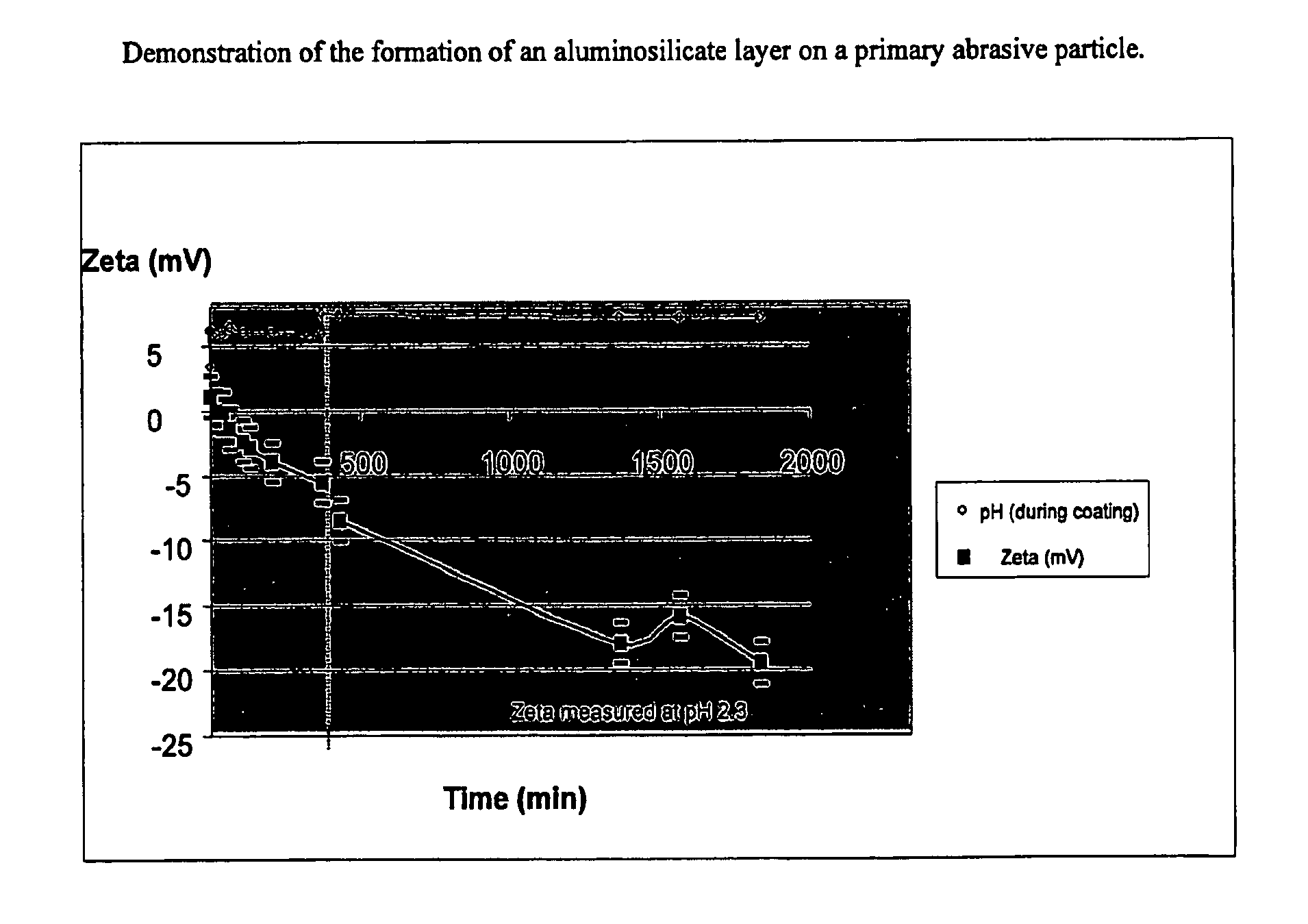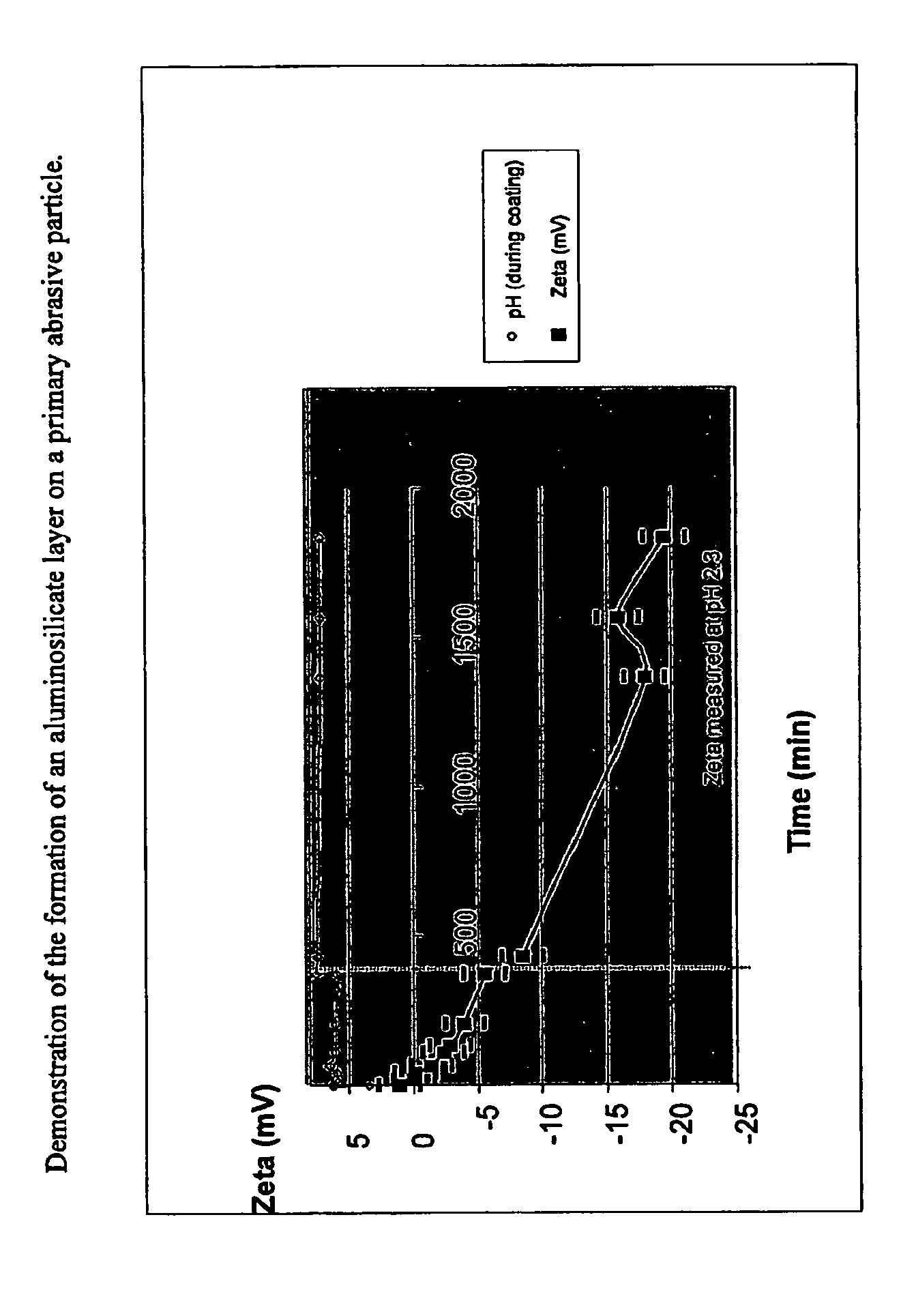CMP method for metal-containing substrates
a technology of metal-containing substrates and polishing compositions, which is applied in the direction of chemistry apparatus and processes, manufacturing tools, and other chemical processes, can solve the problems of low product defectivity, high defectivity, and lowered yield in integrated circuit manufacturing, and achieve excellent polishing properties of the substrate being polished. , the effect of low defectivity
- Summary
- Abstract
- Description
- Claims
- Application Information
AI Technical Summary
Benefits of technology
Problems solved by technology
Method used
Image
Examples
example 1
[0033]This example illustrates one method of preparing negatively charged particles for use in tungsten CMP slurry formulations. An aliquot of 29.45 g of a 14.4% suspension of fumed silica particles was suspended in deionized water to give a final concentration of 1.72 wt. % particles in a total volume of 247.5 ml. Then, 2.5 ml of a 0.1M solution of aluminum nitrate (Al(NO3)3.9H2O) was added to the suspension. The pH of the mixture was increased to 6.0 by adding ammonium hydroxide solution (29%) and the mixture was left under agitation for 6 hours. The zeta potential of the particles was recorded over time using a Malvern Zeta Master 3000 (Malvern Instruments, Ltd., Worchestershire, UK). In order to measure the zeta potential, a few drops of the mixture were removed and added to a water-based solution pH-adjusted to 2.3 using nitric acid. A zeta potential of −5.5 mV was obtained (FIG. 1), indicating that an aluminosilicate layer had formed (the zeta potential of silica at pH 2.3 is ...
example 2
[0034]This example illustrates the ability to control the thickness and charge density of the aluminosilicate layer on the silica particles, and hence the particle charge, by adjusting the pH. The particles were treated as described in Example 1, except that the pH was increased to 9.0 instead of 7.5, using a 29% ammonium hydroxide solution. After 24 hours the zeta potential of the particles was −30 mV (measured at pH 2.3).
example 3
[0035]This example demonstrates the effect on removal rate using the particles of the present invention.
[0036]These polishing experiments were conducted using an Integrated Process Equipment Corp. (IPEC, San Jose, Calif.) Avanti 472 polishing tool and 200 mm test wafers. All experiments used an IC 1000™ polishing pad (Rodel Inc., Phoenix, Ariz.) and the following process conditions:
[0037]
Down force 5 psiBack pressure 0 psiPlaten speed60 rpmCarrier speed40 rpm
[0038]The control slurry was the commercially available Semi-Sperse® W2000 (Cabot Microelectronics Corp., Aurora, Ill.). The experimental slurries used the same formulation as the commercial slurry, except that the abrasive was replaced with the surface modified abrasive described in Examples 1 and 2, above. In all treatments, the surface modified abrasive was prepared just prior to addition to the slurry.
[0039]The first set of polishing experiments compared two different abrasive concentrations (3 and 1% solids) and oxidizer co...
PUM
| Property | Measurement | Unit |
|---|---|---|
| pH | aaaaa | aaaaa |
| total volume | aaaaa | aaaaa |
| polishing composition | aaaaa | aaaaa |
Abstract
Description
Claims
Application Information
 Login to View More
Login to View More - R&D
- Intellectual Property
- Life Sciences
- Materials
- Tech Scout
- Unparalleled Data Quality
- Higher Quality Content
- 60% Fewer Hallucinations
Browse by: Latest US Patents, China's latest patents, Technical Efficacy Thesaurus, Application Domain, Technology Topic, Popular Technical Reports.
© 2025 PatSnap. All rights reserved.Legal|Privacy policy|Modern Slavery Act Transparency Statement|Sitemap|About US| Contact US: help@patsnap.com


